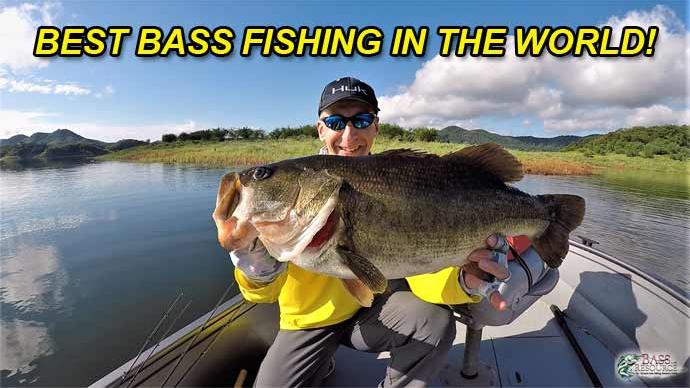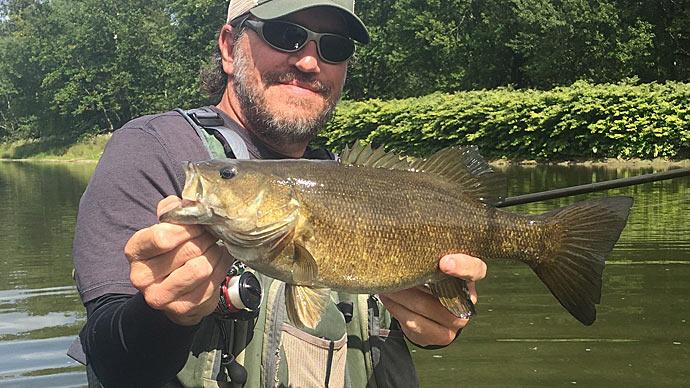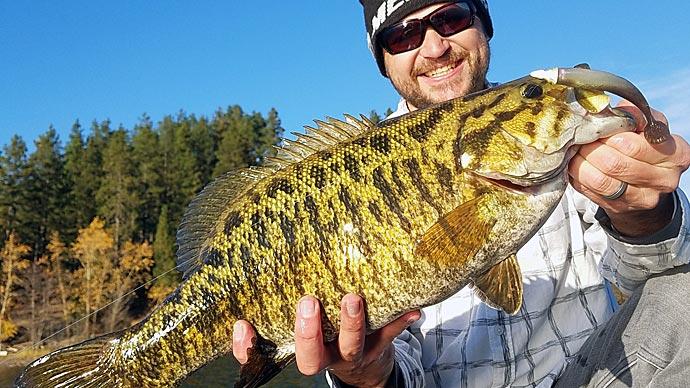
Bill Lortz picks and chooses when he fishes Oneida Lake, the largest lake in New York state. “My favorite time of year at Oneida is May,” he said. “The first couple weeks in May, I’m always booked for Oneida.” He bookends those 20 or 25 trips during the state’s early catch-and-release season with a handful more in the fall when it's a big smallmouth feast in preparation for a long winter.
While the call of trips elsewhere takes Lortz, who operates N.Y. North Country Bassin’ Guide Service, away during summer, fishing remains strong on Oneida. At almost 51,000 acres and nearly 80 miles of shoreline, it regularly hosts local, regional, and national tournaments, including the Bassmaster Elite Series several times. It also sees plenty of action from recreational anglers, which target its abundant smallmouth and largemouth bass along with its well-known walleyes.
It’s hard to find a lake that’s easier to access than Oneida. It’s minutes from centrally located Syracuse, its airport, and the intersection of two major interstates. I-90 takes you west to the Finger Lakes, where fishing, boating, and wine tasting awaits, and east to Utica, Albany, and New England. And north-south I-81 takes you to one of the state’s other world-class smallmouth fisheries, the St. Lawrence River. Oneida is a year-round fishing destination if you’re a multispecies angler who enjoys ice fishing. Bass anglers find consistent fishing for smallmouth and largemouth from ice out to ice up.
Sassy and shallow
Wide-open Oneida’s longest wind fetch is situated almost perfectly east and west. And being a relatively shallow lake with a maximum depth of 55 feet and an average depth of 22.3 feet, according to the New York State Department of Environmental Conservation, it can turn rough in short order. So, it always pays to pay attention to the boating forecast and which of the many state, county, and private boat launches you use.
Lortz said the wind at Oneida predominately blows from the west and southwest. Most days, that isn’t a problem when you launch at Oneida Shores, a county park that also offers swimming and camping at the lake’s extreme western end. It has an eight-lane ramp, plenty of parking, and is less than 1 mile from I-81. Even if the wind is blowing strong, it’s a short ride to the well-sheltered Oneida River, part of the New York State Barge Canal System and a favorite fall destination of the lake’s smallmouth. While it offers miles of bass fishing, the section closest to the lake is no-wake, making for a time eating idle in and out.
Keep your eyes on the sky and GPS mapping, especially when running to the next spot. Oneida, especially its western half, is filled with shoals, long shallow points, and rock piles. Finding one at speed can end your trip, and maybe more, in a hurry. Most of these shallow spots are marked with white pin buoys. But it’s always a smart move to first idle through sketchy stretches, laying down a GPS track. Once you know it’s clear, you’ll have a safe route to follow.
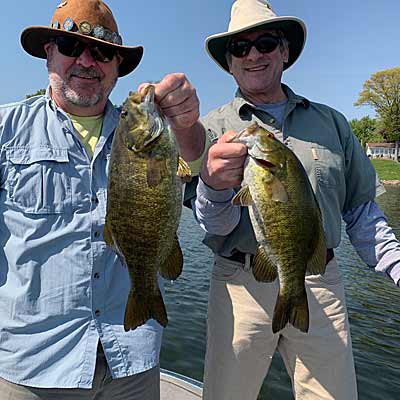
While wind and waves have always been a concern on Oneida, it has changed in recent years. Its water has cleared thanks to filter-feeding zebra mussels, which arrived about 30 years ago. Now aquatic vegetation grows to about 20 feet deep. And within the past ten years, the lake has seen the arrival of round gobies, the invasive bottom-dwellers that have jumpstarted smallmouth growth rates across the Great Lakes.
Gobies are affecting Oneida’s smallmouth in a couple of ways. They’re making them bigger, and Lortz said they’re changing where they swim. While a percentage of the population still chases schools of baitfish, predominantly yellow perch, throughout the lake, more are staying shallow and orienting to the bottom. “At the end of the day, they take the easiest meal they can get,” he said.
Oneida’s shallow water is good for fishing. Lortz said 5 to 10 feet is considered midrange, and 20 feet is at the deep extreme. But it’s incredible how many bass — largemouth and smallmouth — are in water less than a couple feet deep. Sometimes it seems they can’t swim shallow enough. That’s a great place to start if it’s your first time at the lake.
Smallmouth one-two
Bass aren’t everywhere, as any angler on any body of water can attest. And Oneida’s smallmouth are no different. For them, the only place to be is where rock and aquatic vegetation mingle. “That’s 100% the key year-round,” Lortz said.
Lortz said Oneida’s aquatic vegetation doesn’t take off until the end of May. But before it does, many of the best local anglers are scouting, searching for isolated shallow stretches and piles of rock throughout the entire lake. He said they’ll mark them on their GPS and return once vegetation grows around them. He has thousands of such waypoints on his units.
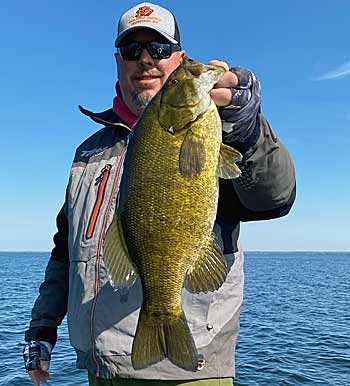
But don’t give up your Oneida plans because you don’t have any of these rock-vegetation spots saved. While they may make your fishing a bit easier, Lortz said you can catch up by focusing on the first drop — it doesn’t have to be big — outside protected spawning spots in late spring or early summer.
Lortz said smallmouth stay in these spots through summer, sliding to slightly deeper rock and vegetation as the water temperature peaks. They remain there until fall’s cooler weather arrives. Then they push shallower to pursue baitfish. They’ll stay there, concentrating on whatever green aquatic vegetation they find until the temperature falls so that they are forced to return to deep water. He said that could be as early as October.
Moving lures are great choices regardless of where smallmouth are swimming. You can catch them ripping a spinnerbait with double willow-leaf blades close to the surface, and vibrating jigs, jerkbaits, and shallow-running crankbaits claim their fair share, too. Lortz offers other options. He said topwaters are productive during mayfly hatches, and small swimbaits, especially those poured by Keitech and in shad or perch patterns, catch smallies from the open-water season’s start to finish. And as gobies become a bigger deal on Oneida, he said the Ned rig is becoming more effective.
Don’t skip the largemouth
Most bass anglers first fish Oneida, which Bassmaster magazine named one of its top 25 U.S. bass lakes in 2020 because of its plentiful smallmouth. On many days, Lortz can catch upwards of 50 of them, most weighing between 2 1/2 and 4 pounds. “It doesn’t matter how you want to catch them, they are biting,” he said. “It’s super fun.”
But it doesn’t take long for new-to-the-lake anglers to discover Oneida’s excellent largemouth fishing. It’s concentrated in specific locations, making it a long-shot option for multiday tournaments. But the plentiful 2- to 3-pounders, along with a chance at a 5-pounder, make it an excellent option for one-day tournaments and fun-fishing outings.
While small schools of largemouth are found scattered around Oneida, most of them swim in its western half. Here you’ll find historic largemouth hotspots such as Billington, Lower South, and Three Mile bays. The most well-known spot is Big Bay, which is in the lake’s extreme northwestern corner, close to the Oneida River’s start. Its eastern shore is littered with laydowns and backwaters. Its western shore is lined with boat docks, and the middle is filled with submerged aquatic vegetation.
Concentrate your casts on the beds of milfoil and other submerged aquatic vegetation. While walking topwaters, rolling spinnerbaits, and vibrating jigs over the tops of the beds works best when light levels are low or skies overcast, many largemouth are caught pitching Texas-rigged soft plastics and jigs into them, using enough weight to ensure they reach the bottom. Natural colors work best in clear water.
Fishing closer to shore, keep your jig and Texas-rigged lure handy. Here vegetation mats from mid-summer through early fall, and emergent water willow rings the lake, creating an essential mix of shallow rock and vegetation. Frogs and toads are good choices, too. You’re fishing shallow, usually a couple of feet of extremely clear water. So, stay back, making long pitches or soft underhand roll casts.


